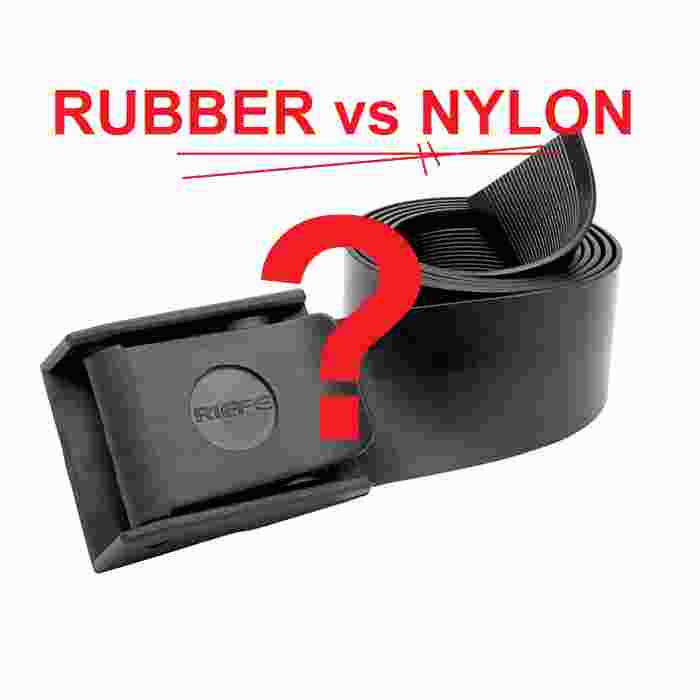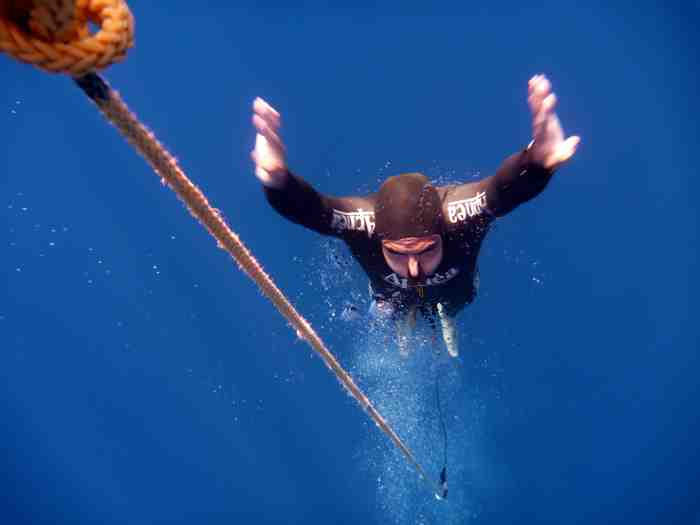- You are here:
- Home »
- Blog »
- Recommended Freediving Gear »
- The Best Weight Belt For Freediving (That Doesn’t Kill Your Breathe-Up)
The Best Weight Belt For Freediving (That Doesn’t Kill Your Breathe-Up)


In this post I discuss the best weight belt for freediving and what material it should have.
When it comes to buying weight belts for freediving, there’s one mistake I see many freedivers make over and over again…
This mistake will not only slowly eat away at your ability to freedive deeply…
But it will also slow your finning speeds and general agility in the water…
And ultimately stunt your growth as a freediver.
What is this mistake?
The big mistake many beginners make when investing in a weight belt for freediving; is they purchase a belt made of the wrong type of material.
What type of material do I recommend?
Every freediver should invest in a rubber belt, specifically I recommend the Riffe Rubber Weight Belt (click here to view price on Amazon). Rubber is the best weight belt material for freediving because it stretches with your diaphragm as you inhale, so doesn’t cut off your breathe-up, allowing for deeper, longer dives.
As for weights – you can’t go wrong with the Sea Pearls Vinyl Coated Lace Through Weights. They’re the perfect fit for rubber belts, so you don’t have to worry about them sliding around during your dive. Click here to check price of these weights on Amazon.
Still have more questions about why rubber is the best material for freediving weight belts? Let’s take a closer look below:
What material should your freediving weight belt be made of?
Freediving weight belts typically have one of two materials: Nylon or rubber.
A nylon weight belt is incredibly durable, lightweight and cheap.
But the fatal flaw of Nylon is that it doesn’t stretch.
Using a nylon weight belt when you freedive can impede your finning technique, make you less mobile in the water…
And constrict your diaphragm during your pre-dive breathe (so you inhale less oxygen resulting in shorter dives).
There are many nylon freediving weight belts on the market.
Avoid them like the plague.
So…what type of weight belt should you buy then?
Why rubber weight belts are the best weight belts for freediving
A rubber weight belt, on the other hand, may be a little harder to slide your weights onto…
But overall is a much better choice for freediving.
Why?
3 reasons:
1) Rubber weight belts help you maximize your pre-dive breathe-up (so you can inhale more oxygen and freedive deeper).
To get the most oxygen possible during your breathe-up; you must inhale deeply into your diaphragm.
If you don’t breathe into your diaphragm; then you’re missing out on a massive amount of untapped oxygen being sucked into your lungs…resulting in shorter bottom times and shallower dives.
But what does your breathe-up have to do with the material of your weight belt?
Well, if you have a nylon weight belt around your waist, you won’t be able to inhale deeply into your diaphragm because nylon doesn’t stretch enough to allow for a full inhale. The nylon belt literally cuts off some of your oxygen supply.
But when you use a rubber weight belt, the rubber stretches as you inhale deeply, so you get the maximum amount of fresh oxygen rushing into your body, ready to fuel you for your dive.
This is the most important reason why you should always choose a rubber freediving weight belt over a nylon weight belt.
2) Rubber is more comfortable than nylon.
Your ability to stay calm, relaxed and comfortable during your freedives, is one of the biggest determining factors of how deep you’re able to dive and how much you enjoy the sport.
If you’re wearing something as inelastic as a nylon weight belt during your freedives; then you’ll start to feel pretty damn uncomfortable and restricted – especially as you dive deeper and pressure changes start to take effect.
If your nylon weight belt makes you uncomfortable…you’ll start to become anxious…and as we all know – anxiety has no place in the water. Stress causes your heart rate to shoot up and eat all your oxygen supplies for your dive.
However, if you’re wearing a rubber weight belt – one that actually stretches and compresses comfortably under pressure throughout your dive…
You’ll be much more relaxed, leading to more conservation of your oxygen and deeper freedives.
3) Rubber weight belts make you more agile in the water.
As you fin through the water, you’ll notice your rubber weight belt will gently stretch to accommodate the extra movement in your waist and hips, leaving you feeling freer and more agile in the water.
Sometimes if you fin while wearing a nylon weight belt, it’s almost like the rigid material of the belt digs uncomfortably into your wet suit and skin. This also restricts your movement, slowing you down in the water.
To ensure you fin with perfect technique and maximum comfort, I strongly recommend going with a rubber weight belt.

Rubber weight belts make you more agile and freer in the water.
I recommend investing in the Riffe Rubber Weight Belt. It comes in a highly flexible rubber that stretches to the natural curve of your body (crucial for maximizing pre-dive breathe-ups)…and the belt has a lightning-fast release buckle for if you need to quickly return to the surface in emergency situations. Click here to check the price of the Riffe Rubber Weight Belt on Amazon.
Why The Riffe Rubber Weight Belt is the Best Weight Belt For Freediving
The Riffe Rubber Weight Belt comes with the following features to make you a better freediver:
Stretchable Rubber Belt: Makes for a nice, comfy ‘second-skin’ type of fit. The rubber in the belt is stretchable, dynamic and flexible. When you bend; it bends. The light-weight, stretchable rubber will have your belt and you feeling like one ultra-hydrodynamic unit torpedoing through the water to hit never-before-reached depths.
Quick Release Buckle The cam-lock glass-filled nylon buckle is incredibly easy to undo during emergency situations. Simply flick it open with one hand, dump all your weights and jet back to the surface and take a big gulp of fresh air. Not only does the buckle look sleek and stylish in black, it can also save your life. 😉
Adjustable Sizing The Riffe Rubber Weight Belt doesn’t have the constraints of a traditional belt buckle of feeding the buckle tooth through pre-set holes in the belt. Instead, the Riffe Rubber Belt has a fully adjustable buckle & belt. Simply slide the belt through the buckle and fasten it to your desired tightness. Never again will you be wearing a belt that’s in between ‘too tight’ and ‘too loose’.
Rust & Corrosion Resistant: The nylon buckle is highly durable. It won’t rust. Salt won’t corrode the belt’s natural shape or degrade the strength of the buckle. You’re investing in a belt that will last the entirety of your freediving career.
Your Weights Stay In Place: Not only does rubber create friction limiting the degree to which your weights can slide around on the belt during your dive…but the belt also has cleverly-designed horizontal lines running across it. These lines act as another safe-guard to securely hold your weights down as you fin.
20lb Weight Capacity; 54″ Long, 2″ wide (The belt is the perfect fit for most of you reading this!).
For the price of just half a tank of gas, you can get your Riffe Rubber Weight Belt by clicking this link here.
Oh, and as for weights – I recommend the Sea Pearls Vinyl Coated Lace Through Weights. They’re the perfect fit and won’t slide around while you dive! Click here to check price of these weights on Amazon.
Best Weights & Items to have on your weight belt

Weighting yourself correctly for freediving is important if you’re serious about improving as a diver.
If you still have issues with your weights sliding around on the belt as you fin, I recommend investing in weight belt keepers.
You may also want to invest in weight belt D-rings which are super handy to hang any accessories off (eg a torch, a knife) – and also act as weight keepers (two birds, one stone!). These are perfect if you want to have your hands completely free throughout your dives.
About the Author Gerrie van Niekerk - Apnealogy
Gerrie is a passionate Freediver, Spearfisher, Digital Marketer, and author for the Apnealogy website. Gerrie is an SSI Level 1 certified Freediver who loves geeking out about freediving and spearfishing gear and lives for his family and adventure.


